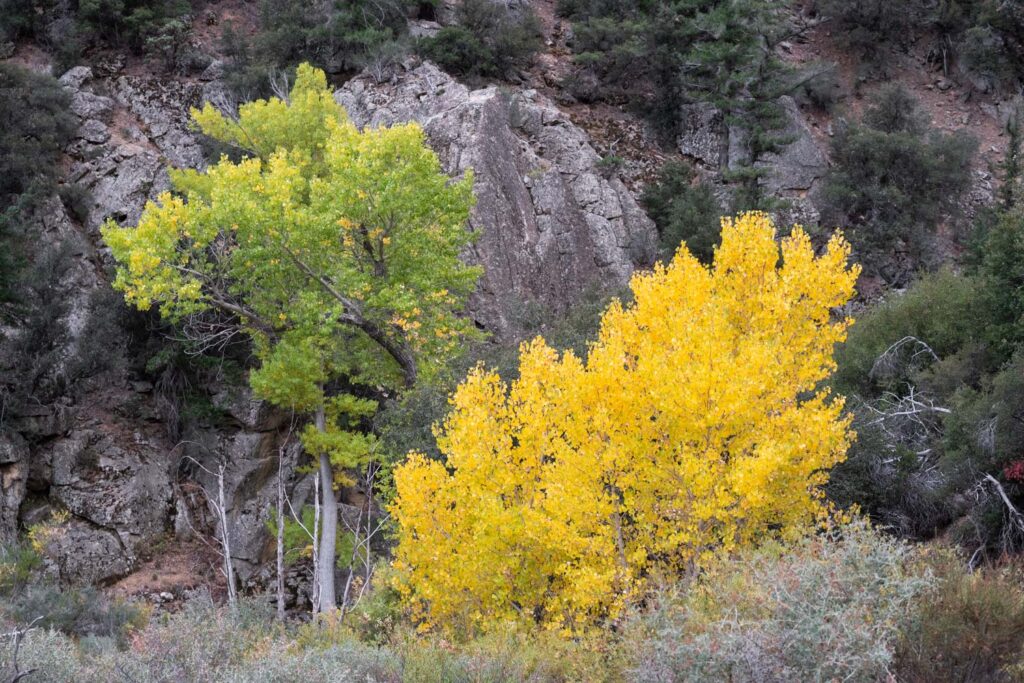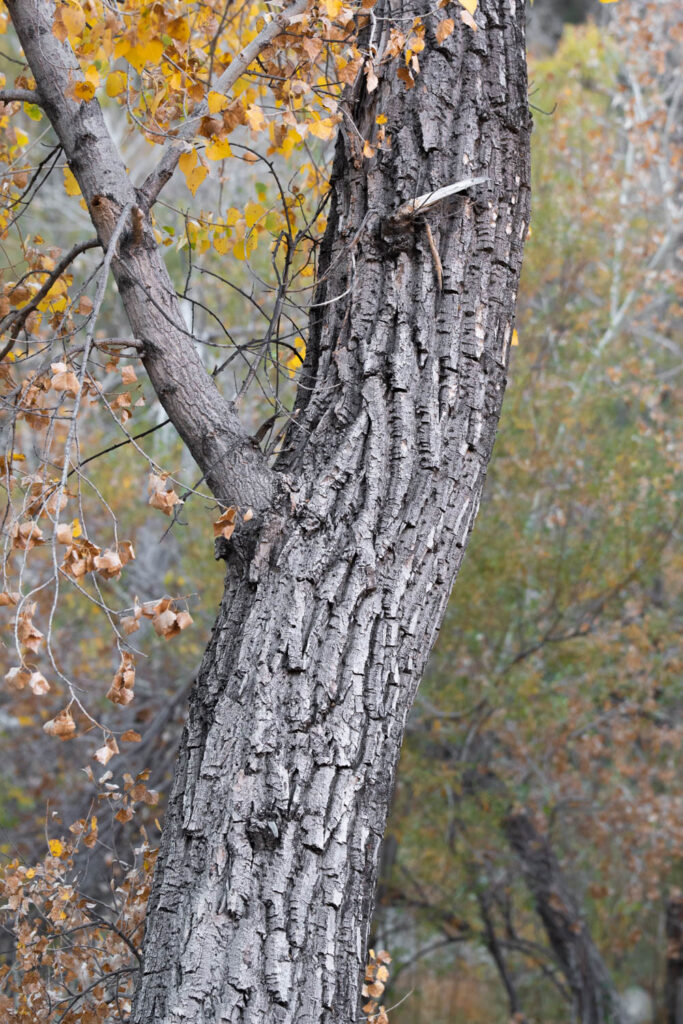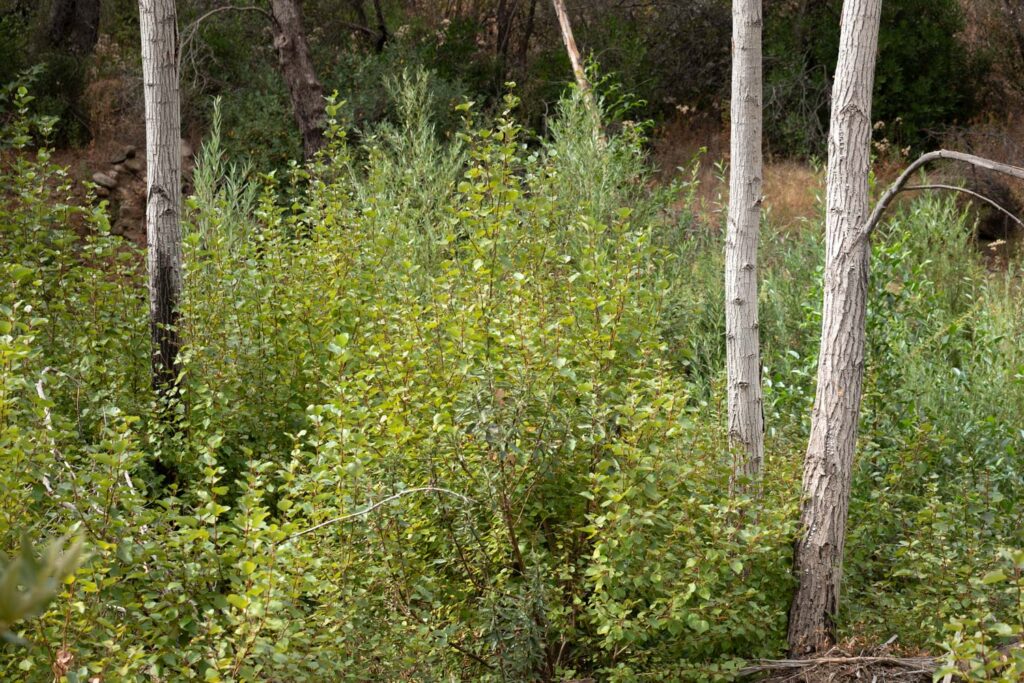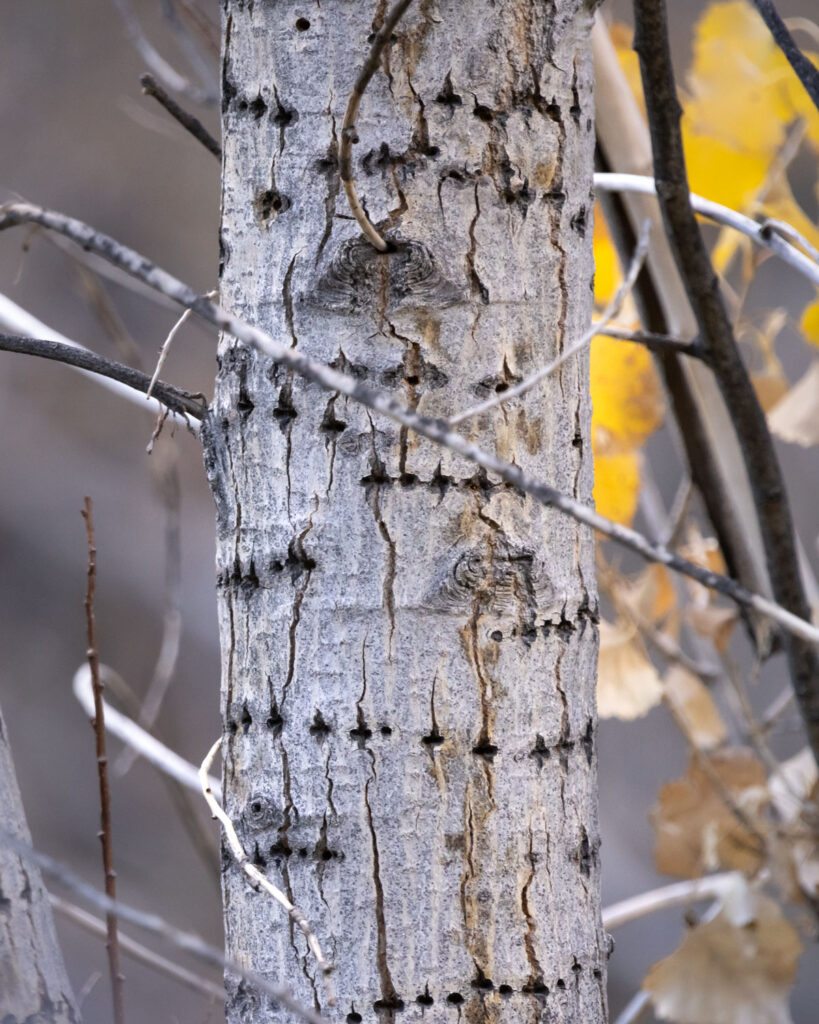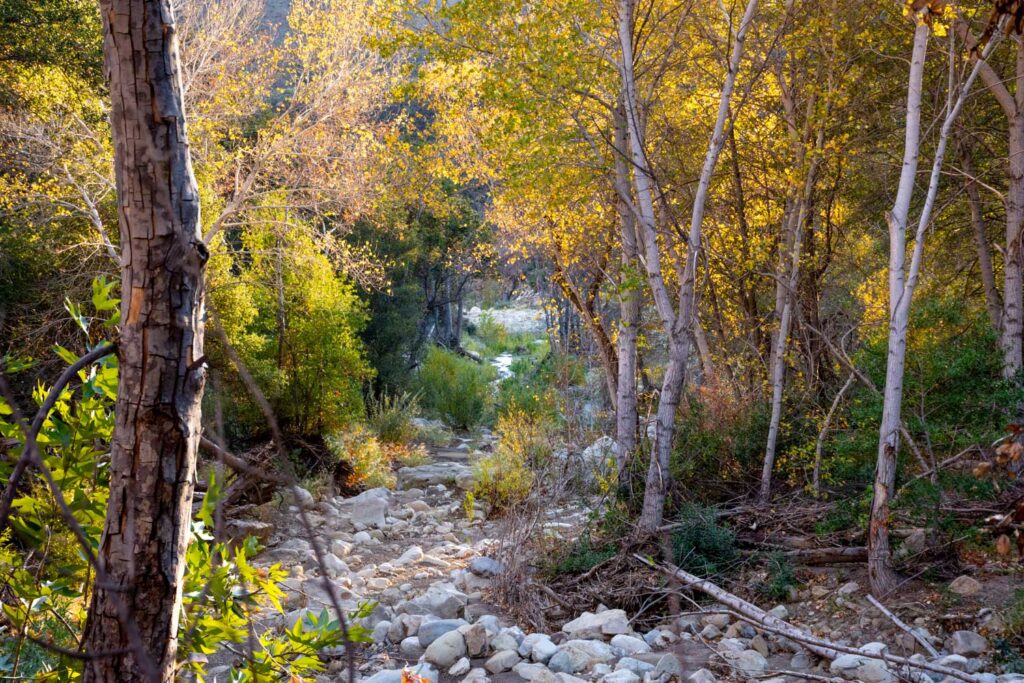Populus fremontii
Populus trichocarpa
Drive through parts of the Los Padres National Forest in November and you may see trees that look remarkably similar to quaking aspens (Populus tremuloides). While the Los Padres has no aspens—the nearest population is in the Sequoia National Forest 75 miles to the north—there are a couple of closely related species that share some of the same characteristics. These are the magnificent cottonwoods which are something like siblings to aspens.
Description
Like aspens, cottonwoods are members of the willow family (Salicaceae) and therefore cousins to the willows which often grow alongside them. There are two types of cottonwood that can be found in the Los Padres: Fremont cottonwood (Populus fremontii) and black cottonwood (Populus trichocarpa). Despite the relationship, cottonwoods tend to be much larger than local willow species and they have easily distinguishable leaves.
Both species of cottonwood in the Los Padres can look quite similar from a distance or even up close. They can grow to up to 70 – 100 feet tall, though Fremont cottonwoods tend to be shorter. Younger trees have relatively smooth gray-white bark which becomes more gray and deeply furrowed with age. Each species has male and female catkins, which are dangling tassels that are a few inches long and full of tiny greenish flowers. These flowers bloom between February and April, and the female flowers eventually give way to small seeds with several white hairs protruding from one end. En masse the seeds and their hairs looks like little tufts of cotton (hence the name) that are easily dispersed by the wind.
The easiest way to tell Fremont and black cottonwoods apart is by examining their leaves. Fremont cottonwood leaves are shorter and squatter (wider at the base, almost triangular or heart-shaped), and they have coarsely “scalloped” margins. Black cottonwood leaves on the other hand tend to have more of an oval shape and their margins have much finer scalloping that’s harder to notice. Black cottonwood leaves also tend to be whitish on the underside. The leaves of both species, however, turn a brilliant yellow in the fall before falling off for the winter.

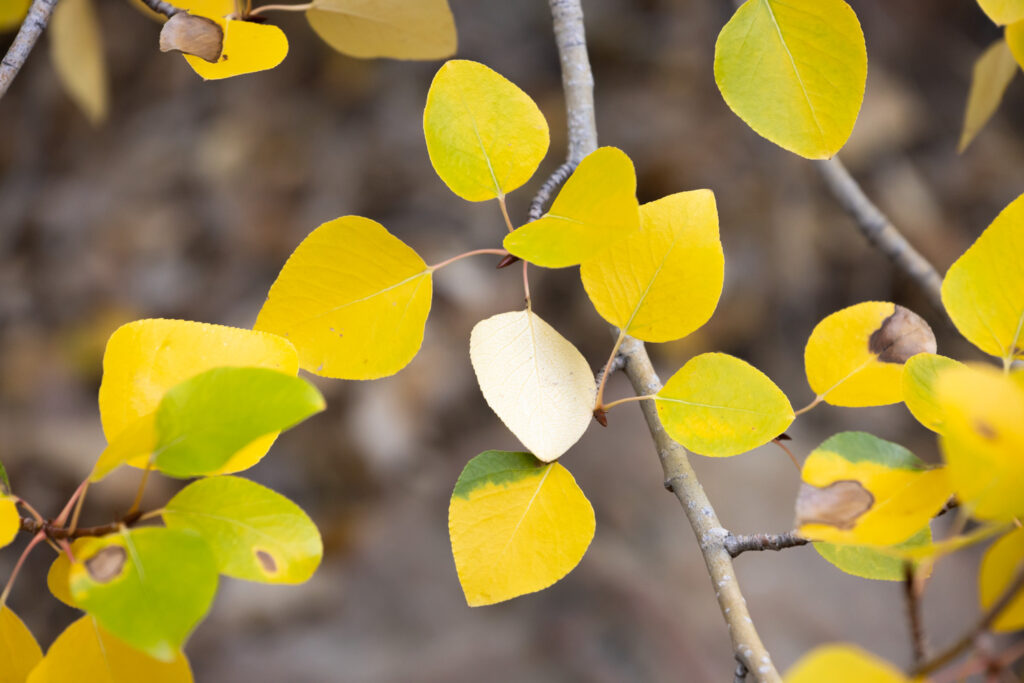
Riparian areas tend to burn less intensely and less often due to localized moisture conditions and topography. However, when they do burn and mature cottonwoods are affected, mature trees are generally “top-killed” by fire rather than killed outright. This means that most of the aboveground biomass dies (though the trunk and branches will usually stick around and slowly decompose long after the fire) while the roots live.
Cottonwoods can readily resprout from the lower trunk and roots after a fire, but their seeds do not germinate in response to heat or smoke chemicals like some woody plant species found in our region. However, seeds can easily be dispersed into burned riparian areas where they will germinate if other conditions are right. We have documented many places after the 2017 Thomas Fire where mature cottonwoods resprouted while dozens or hundreds of new seedlings and saplings are growing nearby.
Where to Find Cottonwoods in the Los Padres
While both species are found primarily in riparian areas—especially in drier areas—Fremont cottonwood is somewhat more common and widely distributed across the national forest. Both tend to grow right next to streams that are often dry much of the year. Cottonwoods are especially adapted to the periodic flooding that naturally occurs in these environments. They also form symbiotic relationships with both ectomycorrhizal fungi that are characteristic of trees and shrubs and arbuscular mycorrhizal fungi that are more characteristic of grasses and other herbaceous plants. The symbioses with both types of fungi is rather uncommon in the plant world, and it likely gives cottonwoods advantages that still aren’t well-understood.
Cottonwoods usually grow next to various willow species and white alder (Alnus rhombifolia), which stick to riparian areas as well. However, you don’t have to stray far from a stream and the cottonwoods alongside it to run into other plants such as manzanitas, ceanothus, and chamise which are common in the chaparral that tends to dominate the landscape. When looking at shrub covered hills and valleys, cottonwood stands can actually serve as a meandering beacon telling you “water is here!”

One of the best places to see cottonwoods, especially when they’re sporting yellow leaves in October and November, is along Sespe Creek near State Route 33. Each year cottonwoods along this road make quite a fall color spectacle that’s hard to miss. Other excellent places to see them in the southern Los Padres are along Wild & Scenic Piru Creek, Upper North Fork Matilija Creek, Santa Ynez River near Red Rock, and Manzana Creek in the San Rafael Wilderness.
Sapsuckers and Aphid Galls
Spend enough time in riparian forests where cottonwoods are common and you’ll likely run into a red-breasted sapsucker drilling holes in perfectly straight lines around the trunks, especially in the fall and winter. These birds spend more time in the higher elevation conifer forests such as those found on Pine Mountain or Mt. Pinos, but as temperatures drop, they come down into the valleys and closer to the coast where they can be found in riparian forests. Look for their tell-tale lines of sap wells and listen for Morse Code-like drumming.
Another interesting animal you can find utilizing both Fremont and black cottonwoods is the petiole-gall aphid. This tiny insect induces the formation of interesting growths in the leaf stems (petioles). These galls begin to form after a female aphid starts feeding on a petiole. This feeding stimulates gall production, possibly due to chemicals in the aphid’s saliva that change the balance of growth hormones in the stem. However, entomologists still don’t understand exactly what’s in aphid saliva that causes the gall to form in the first place. Regardless, the hollow gall eventually envelops the female who will then go on to lay several eggs inside. These eggs hatch and the young aphids will eat the inside of the gall while developing into adults. They may move on to other galls if it becomes overcrowded. These petiole galls and the aphids inside are food for green lacewing larvae and various bird species.
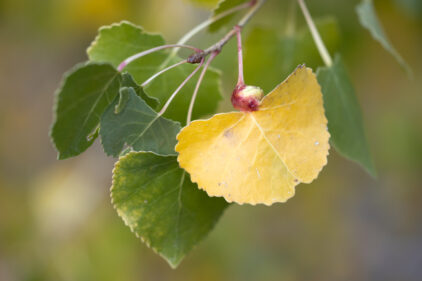
Cultural Importance and Conservation Threats
Both Fremont and black cottonwoods have long been used by Indigenous peoples across the southwestern North America, including the Chumash along California’s central coast (cottonwoods are known as qweleqwe’l in the Barbareño Chumash dialect). According to Chumash Ethnobotany by Jan Timbrook, cottonwoods have been one of the primary construction materials for traditional house building. These trees are also important for creating wooden bowls and other containers, and they have even been used for making skirts!
Cottonwoods are also emblematic of riparian areas in the arid Southwest and much of California. This is why much attention and research has focused on how these species cope with climate change and intensifying drought. While not considered endangered or threatened, populations in some parts of their range have been declining due to climate change, water diversions, and competition with highly invasive plants such as tamarisk (saltcedar). The Los Padres National Forest does in fact have issues with this group of non-native shrubs that can take over riparian areas, especially downstream of dams and other heavily disturbed areas. Like many other conservation organizations in the region, ForestWatch has worked on tamarisk removal projects along the Santa Ynez River and elsewhere over the years.

